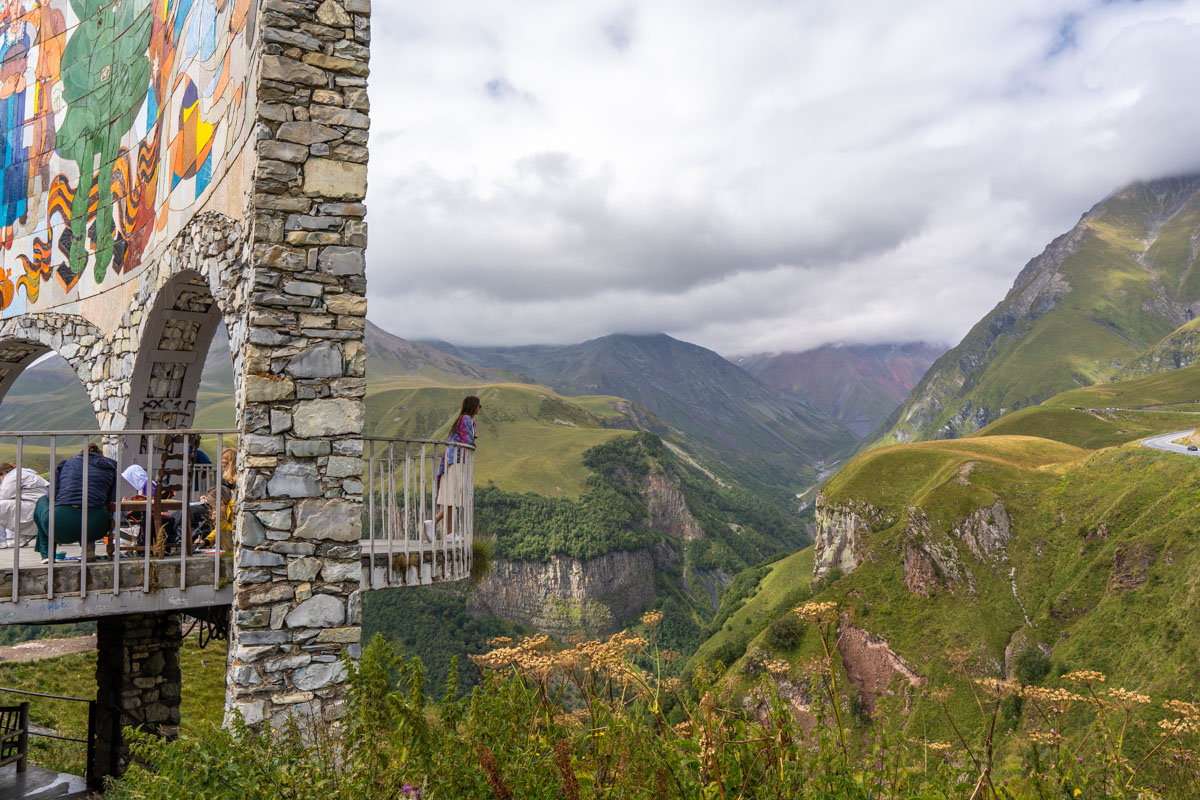
Within the southern Caucasus is where you’ll discover Azerbaijan, Georgia, and Armenia–three countries with ancient traditions, breathtaking scenery and modern influences. Whether you’re exploring the charming streets of Tbilisi, Georgia, the historic monasteries in Armenia or the futuristic buildings in Baku, Azerbaijan, this region has a lot to offer. Because of the proximity of these countries and how far it takes to travel there, taking an Azerbaijan, Georgia, Armenia tour will be the best way to explore the Caucasus region.
Due to my lack of knowledge on this area in general, I wrongly assumed these three countries would be very similar. That wasn’t the case at all. While they share borders and are usually lumped together because of their location, I found that they all had pretty distinct differences.
I took a 12-day trip with Arara Tour through this region to explore the highlights. It was great not to have to worry about any of the travel logistics or border crossings, and we had wonderful local guides in each country who were very knowledgeable and helpful.
Where are Azerbaijan, Georgia and Armenia?
First things first, where is the Caucasus region? When I checked into my flight to Baku, Azerbaijan, the attendant had no idea where I was going and no idea which part of the world it was. And that was a pretty similar consensus for every person I told. So here’s a little map for help:
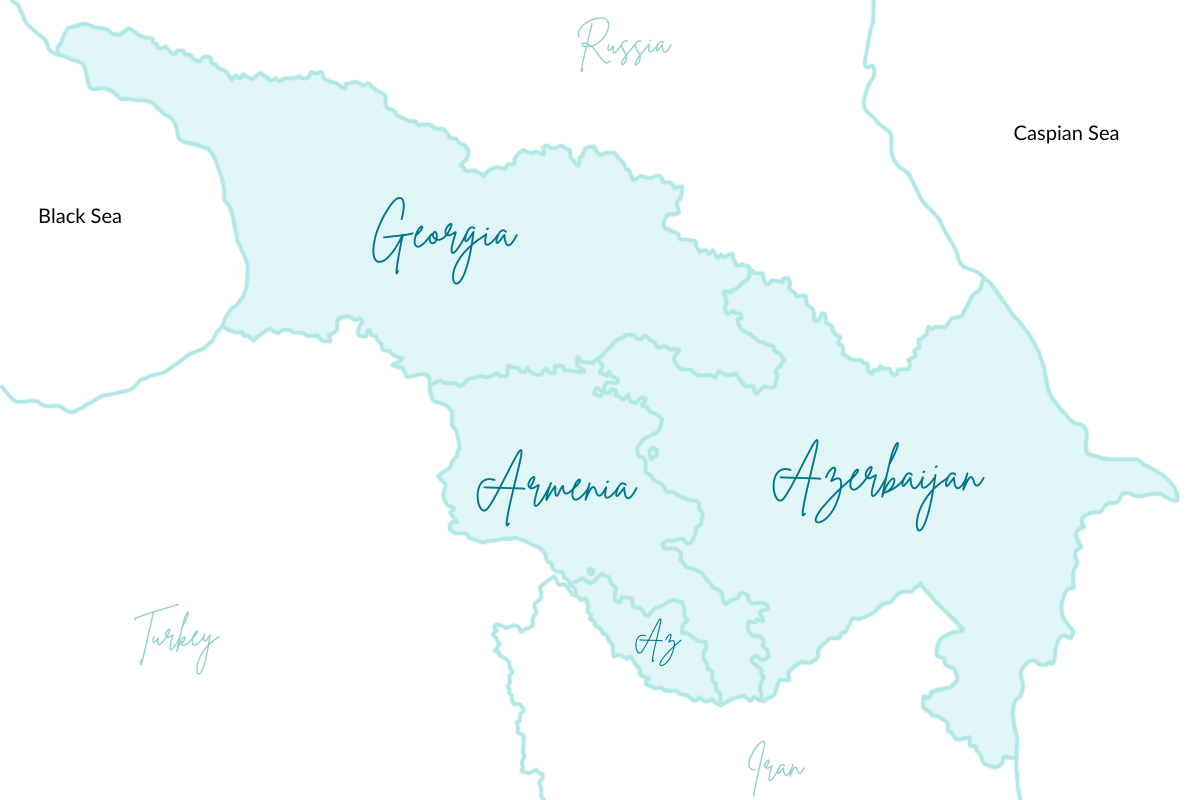
The Caucasus region is the area between the Black Sea and Caspian Sea where the Caucasus mountains intersect between Europe and Asia. You’ve got Russia to the north and Turkey and Iran on the southern side.
Even within the mountains. you’ll get some different landscape depending on where you visit. There are some dry, arid areas but lots of lush, green mountainsides. Because of the climate here, Azerbaijan, Georgia and Armenia are some of the oldest wine-making countries in the world.
Are the Caucasus part of Asia or Europe?
This is the question. But geographically, Europe’s borders include part of Georgia and Azerbaijan, so technically they are transcontinental. Armenia, although located to the west of Azerbaijan, is considered to be entirely in Asia.
Culturally, they probably align with all the regions: Western Asia, the Middle East and Eastern Europe. But if we’re looking at politics, they align closer with Europe.
Azerbaijan Georgia Armenia Tour
Where to Start
This is very important as you don’t want to run into any issues at immigration when visiting any of these countries. Currently, the border is closed between Azerbaijan and Armenia. You can see on the map above that there is a section of Azerbaijan that isn’t connected to the rest of the country and there are a few territory disputes.
Additionally, if you visit Armenia before Azerbaijan, they can deny you entrance into Azerbaijan. It’s an easy solution though, you’ll just make sure you visit Azerbaijan first, cross the border to Georgia and then make your way into Armenia.
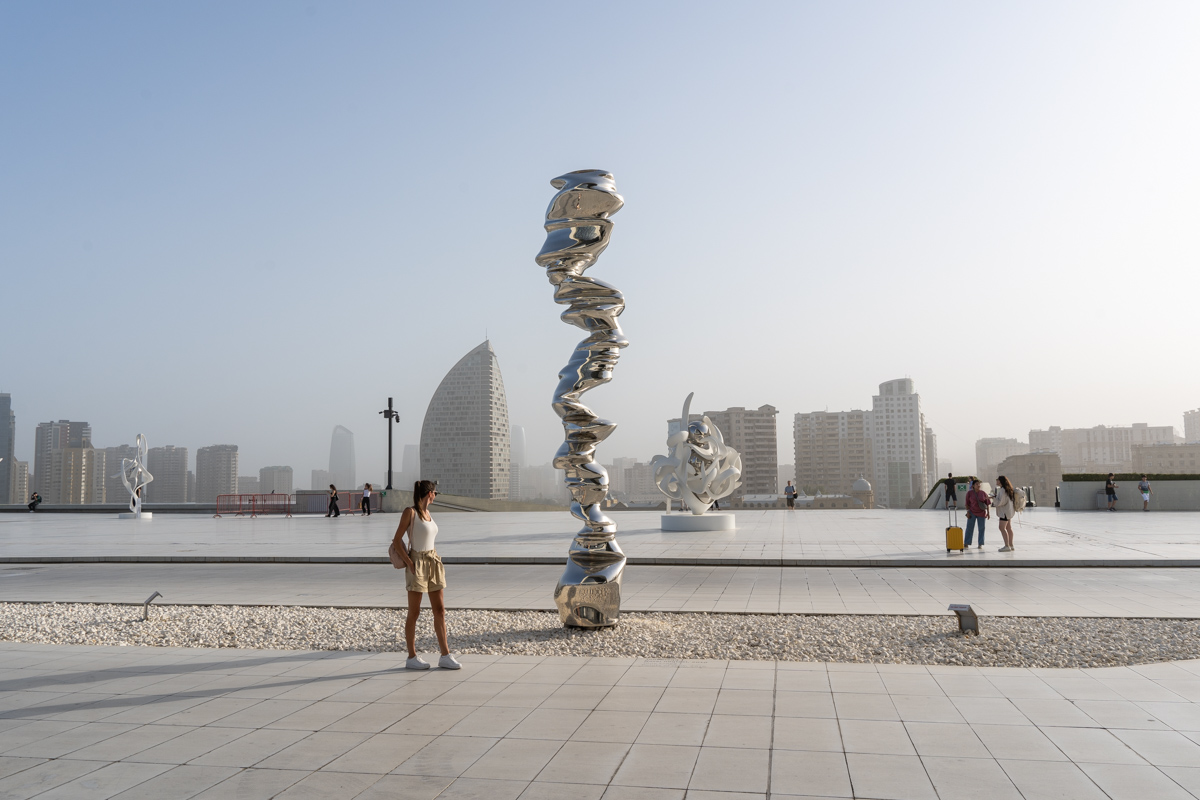
Even better, if you’re on a tour through the Caucasus, this will all be pre-arranged for you and taken into consideration.
But because of the border closing, you’ll also need to keep in mind that you’ll start your Azerbaijan, Georgia, Armenia tour in Baku, but then you’ll be flying out of Yerevan, Armenia. So you’ll likely be booking one way flights in and out instead of a roundtrip ticket. And if you do book a roundtrip ticket from Baku, you’ll need to connect somewhere before flying back to Baku as there are no direct flights from Yerevan to Baku.
Azerbaijan
The capital of Azerbaijan, Baku, is located on the east side of the country next to the Caspian Sea. It’s where you’ll likely fly into and it’s a great city to start your exploring. The country is a major producer of oil and gas, so there’s definitely wealth in the country, albeit not on the levels of the UAE.

One of the first things I noticed after arriving in Baku was how clean the main part of the capital is. Sidewalks, streets, the buildings in the main areas, all seemed very well taken care of. And there are a lot of nice areas within the city.
Baku
The capital city is an interesting place to explore. It’s a contrast of new, modern buildings and old, historic areas. There are lots of outdoor cafes and a boardwalk along the Caspian Sea. You can spend several days here as there are many places to visit in Baku.
The Flame Towers are an iconic modern structure with three buildings that curve outwards resembling a flame. They even light up at night with flames on them. Martyrs’ Lane is an outdoor memorial for those killed by the Solviet army and is a large park area that leads to an overlook of the city.


The Carpet Museum is in the shape of a long roller carpet and there’s many other government buildings and theaters to see. One of the most iconic buildings in Baku is the Heydar Aliyev Cultural Center–a curved modern building overlooking the city that houses art exhibits.
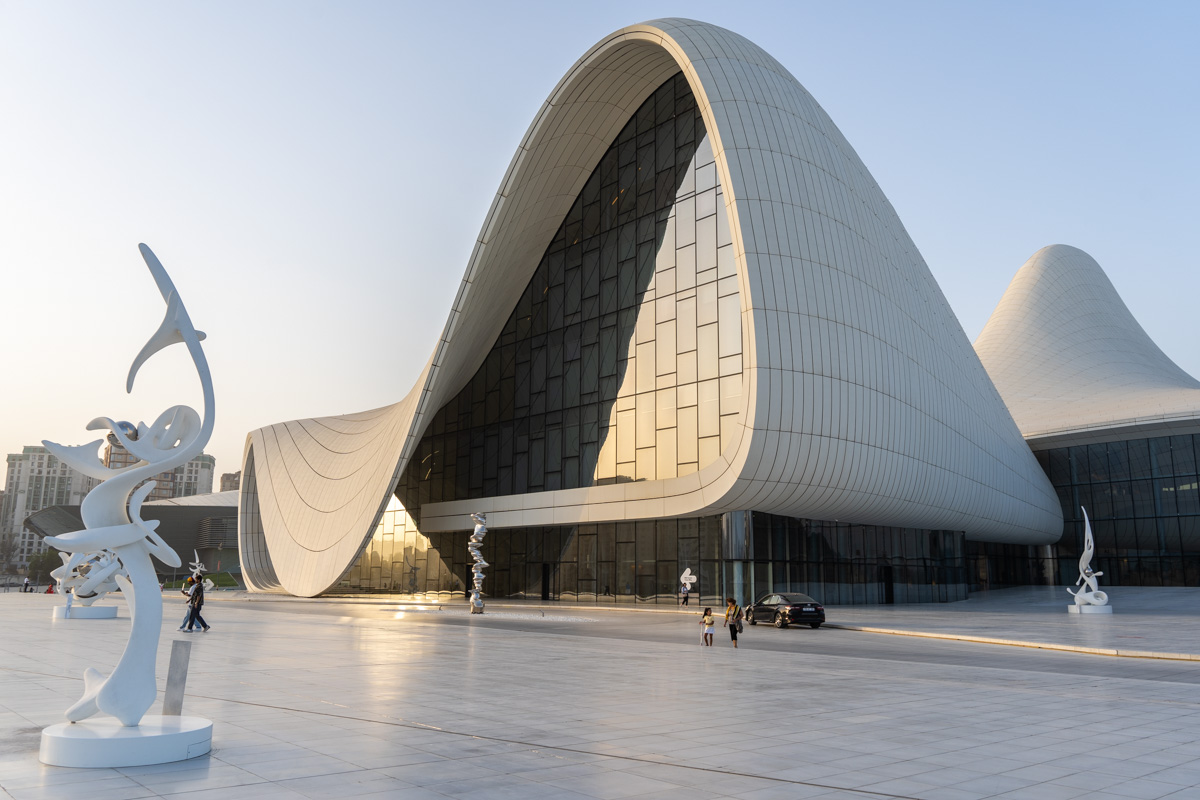
Baku also has an Old City surrounded by a fortress wall. When we visited, it was actually about a week before the Formula 1 race so there was lots of barriers up for the track. The track shuts down one of the main streets in town and one of the steepest and sharpest sections is right next to the fort with the barriers being a foot away from the fortress.
Inside the walls, you’ll find the Palace of the Shirvanshahs and the Maiden Tower which is the oldest building in Baku’s Old City.
Gobustan National Park
About an hour outside of Baku is Gobustan National Park, a UNESCO World Heritage Site that has ancient petroglyphs. There are quite a few to see along the walking trail here.
One of the best parts though is heading out to the mud volcanoes afterwards. We ditched our van for some taxi drivers in old Soviet cars because they are indestructible (even though they looked like they’d been through it). But they all took off in different directions once we went off the main road.
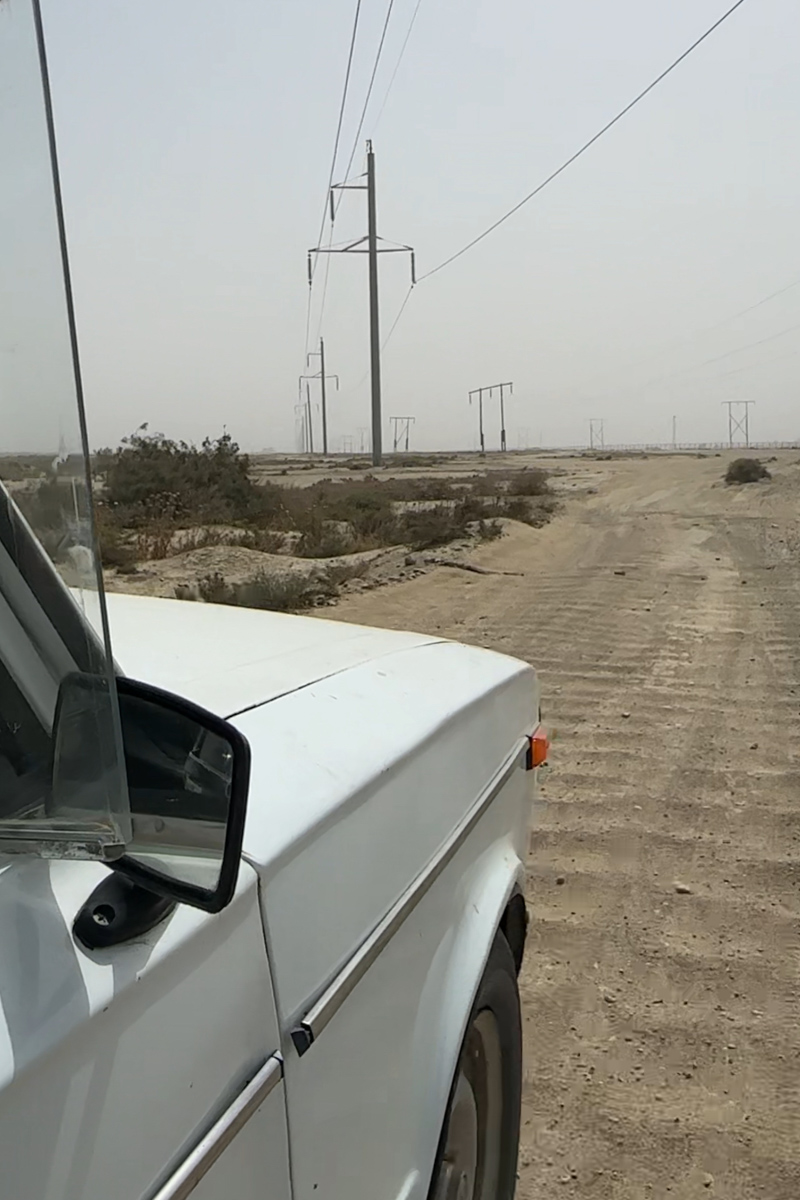

The area is pretty barren and there were some ‘roads’ heading out into the middle and a lot of free-for-all-paths taken too. Our car was falling apart speeding along but the funny part is, another car would come speeding out of nowhere and cut in front of us. It was like a little desert race out to nowhere.
When we arrived at the volcanoes, our driver got out a water jug because he’d burned up the engine, ha.
The mud volcanoes are interesting because they’re just bubbling hills of mud. You can touch them too–they aren’t hot, but it is a strange phenomenon.
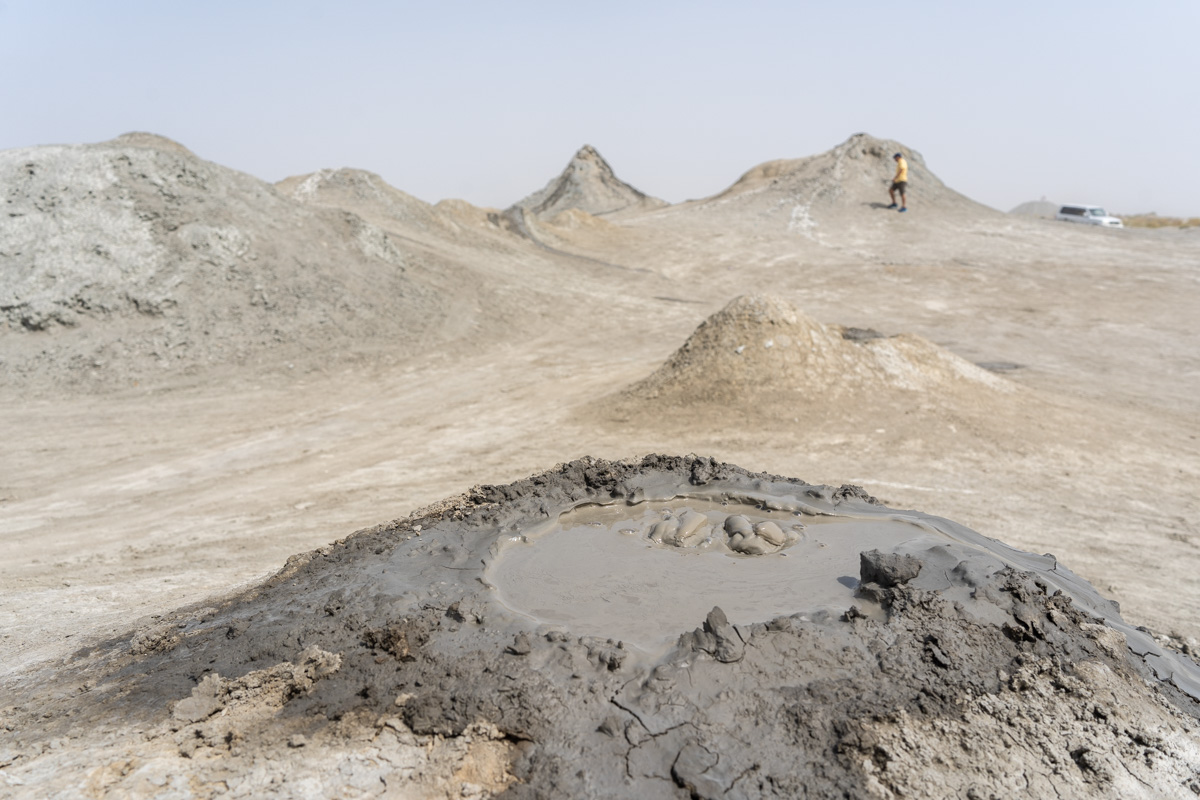
Sheki
Once you start to head northwest in Azerbaijan, you’ll come across a town called Sheki in the Caucasus mountains. Sheki was one of the towns along the Silk Road, so if you’re on a Silk Road tour, this will be one of your stops in Azerbaijan as it’s now a UNESCO World Heritage site.
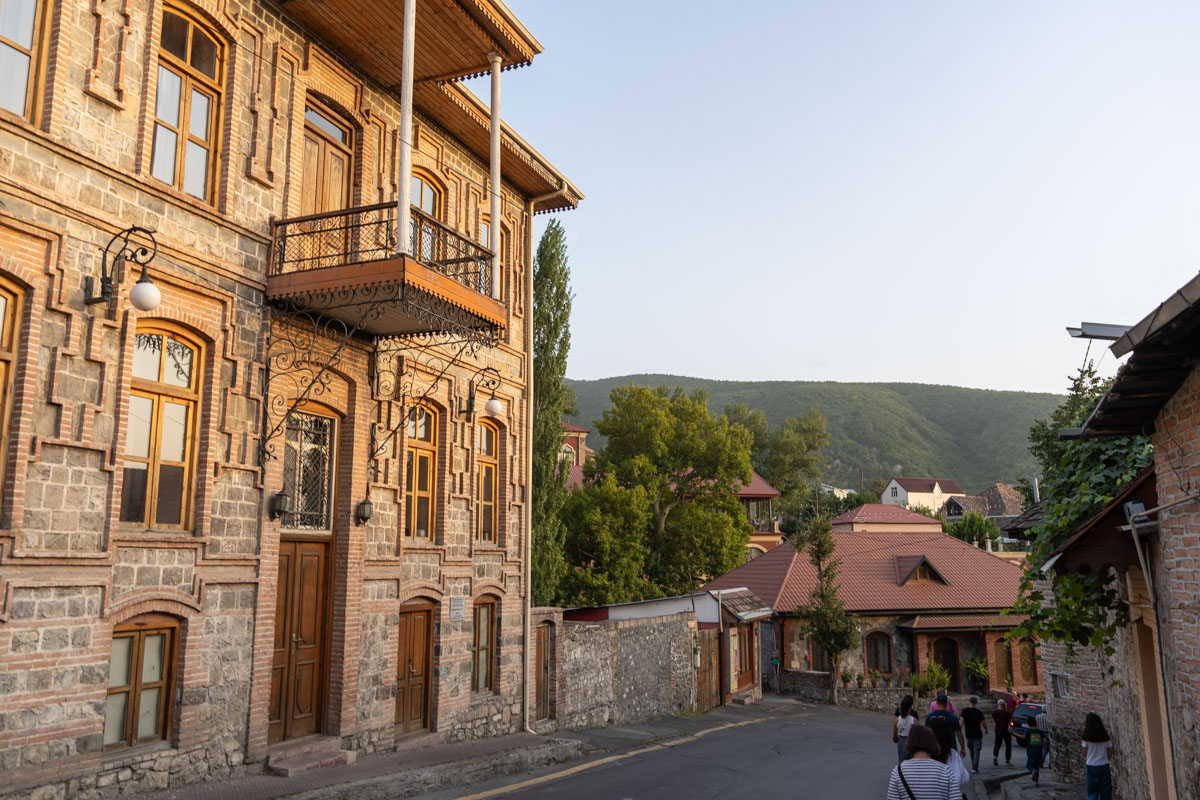
A popular spot of visit is the palace of the Sheki Khans where you can see beautiful painted interiors and stained glass windows. We walked through some of the artisan streets where you can find ceramics, silk scarves and sweets. There’s lots of shops to pop into and really cute outdoor restaurants. We found one that had a large courtyard with live music.
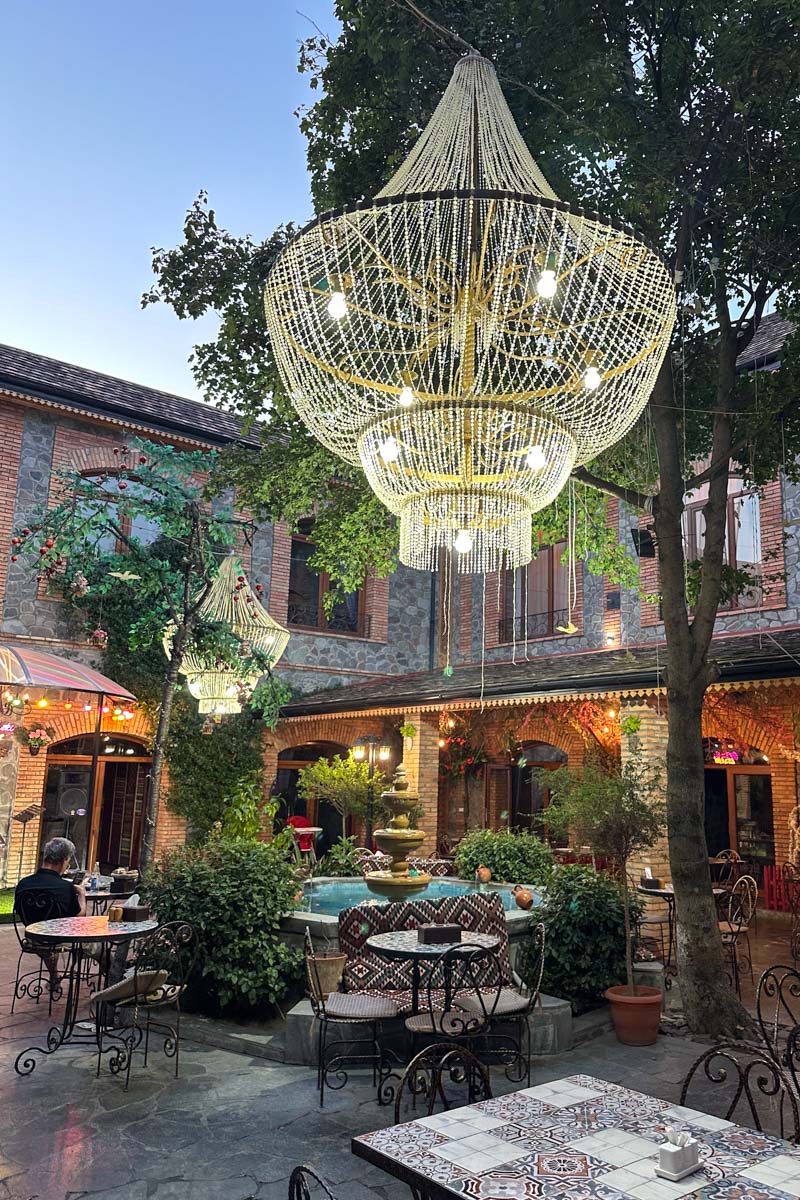

The restaurants and hotels here have a completely different vibe than Baku. Our hotel had stone interiors and an outdoor courtyard with hanging lanterns. It’s definitely a cute place to explore before heading on to Georgia.
Georgia
I was completely surprised walking into Georgia. And not just because I had to walk a mile through the border crossing and drag my suitcase up broken stone ramps. But I was taken aback by the scenery I was met with on the other side. We started to see a little bit of that change coming from Sheki but once we were in Georgia, it was rolling green hills and wineries.
I can’t really explain it, but Georgia was one of those places that I knew I would love immediately. And I wasn’t wrong. Of all the places on my Azerbaijan, Georgia, Armenia tour, this was my favorite.
Sighnaghi
When you first cross the border into Georgia, one of the first towns you come across is Sighnaghi in the Kakheti region, which is popular for its wineries. It’s a cute walkable town in the middle of wine country with beautiful views, stone walls and cobblestone streets. It’s a great place to stop for lunch and for the afternoon on your way to Tbilisi.

A highlight here is a walled fortress around the town that you can walk along and step into the turrets. The views from here are beautiful and it’s a very cute place to spend an afternoon.
Telavi + Kakheti Wine Region
A must in Georgia is visiting the wine regions. Georgia is said to be the oldest wine-making country in the world and has more than 8,000 years of wine history. There are 527 different vines of grapes found here and 350 are used for wine making.

Another fun fact is that most Georgians make their own wine at home! If you have the space, it’s very common. It takes about 4-5 months to a year to make a batch of wine, depending on the grape. They’ll also make their own chacha, a Georgian pomace brandy made from the skin of the grapes. It’s also referred to as ‘vine vodka’ or ‘grape vodka’.
Our bus driver brought a small bottle of his own so we could try it. So we all downed shots of chacha at 9:00 in the morning, and depending on who makes it, it can be pretty strong.
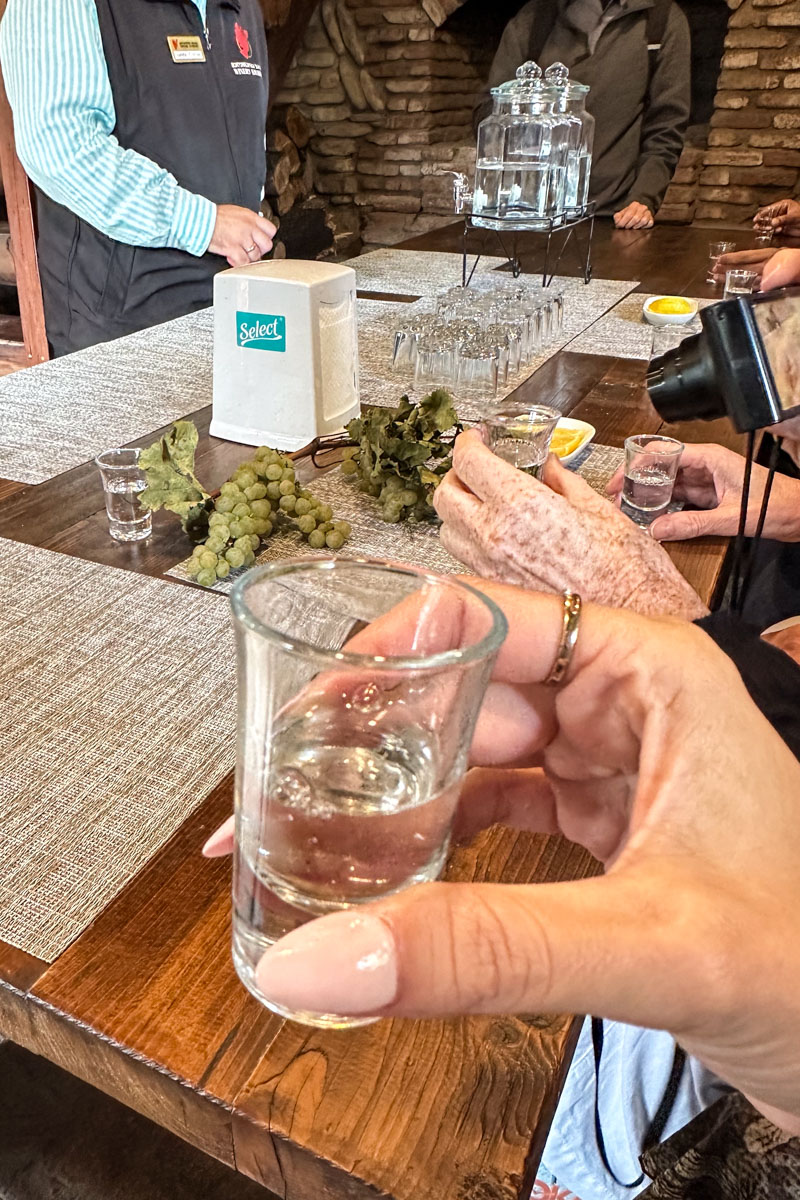
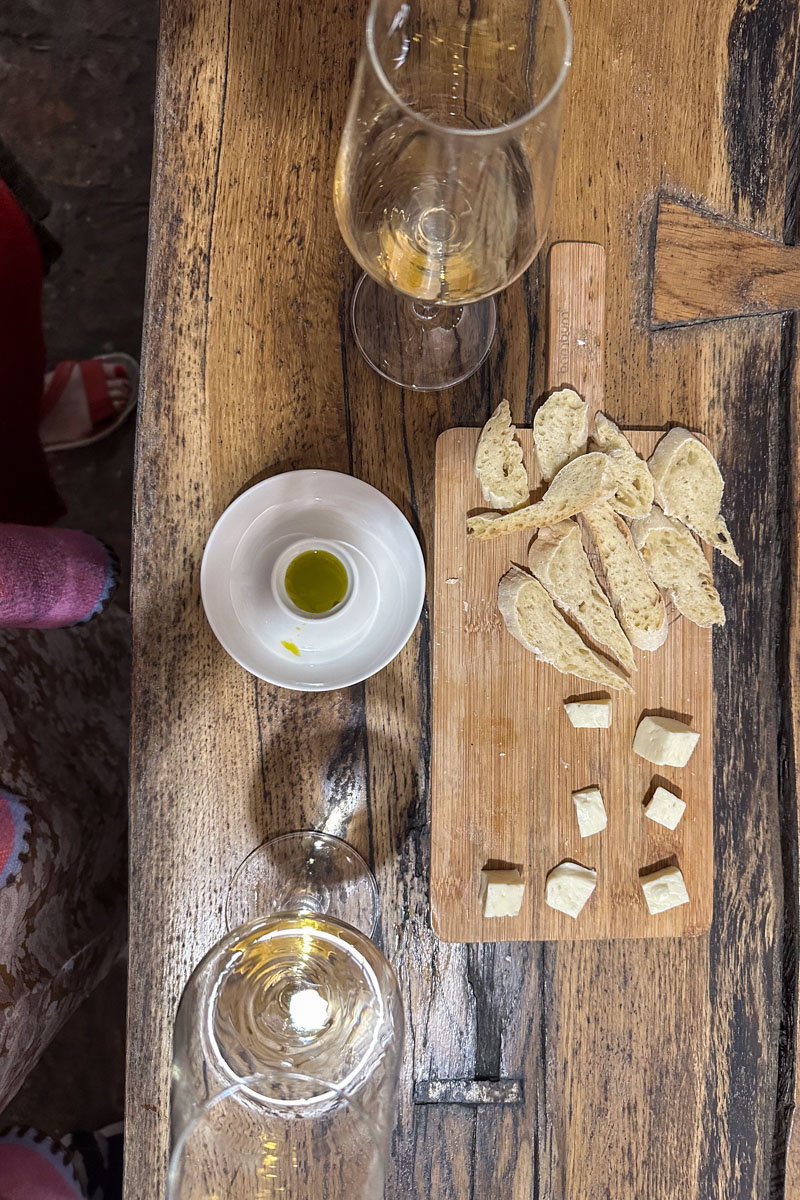
Telavi, Georgia is the main city in the Kakheti wine region. Here you’ll find traditional homes and carved balconies with beautiful views of the mountains. Make sure to visit the Tsinandali Estate nearby where Georgia wine was first bottled! You can tour the estate, the historic winery and try some wine here also.
We went to a local winery called Khareba which produces 10-12 million bottles of wine each year. Within their wine tunnels are 26,000 bottles of wine that are part of a private collection. They also do a wine tasting within the tunnels and afterwards, we tried chacha, churchkhela (the Georgian snickers) and got to make some local bread.


Tbilisi
The capital of Georgia, Tbilisi, is also a great city. Somewhat like Baku, it’s a mixture of old and new, though here it seemed to blend together in less of a stark contrast. It’s an easy city to walk around and explore, and I could have easily stayed here longer. The food and wine alone could have kept me.
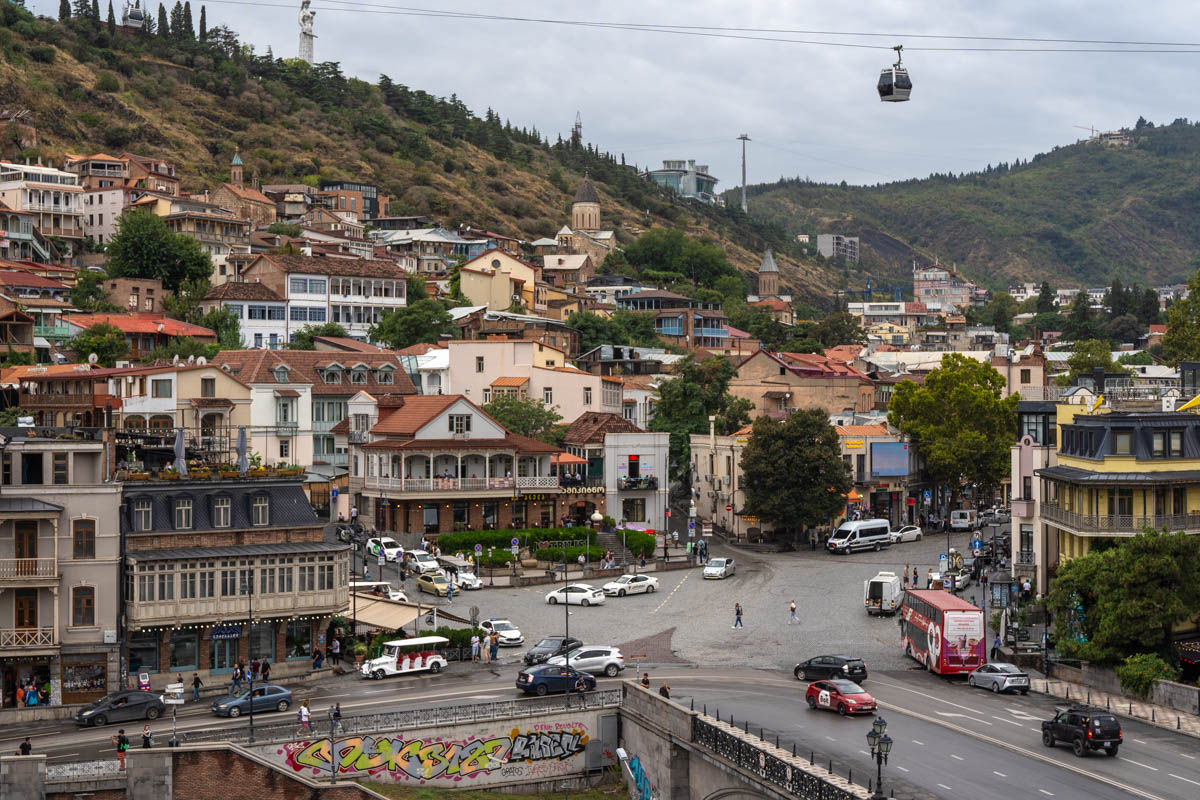
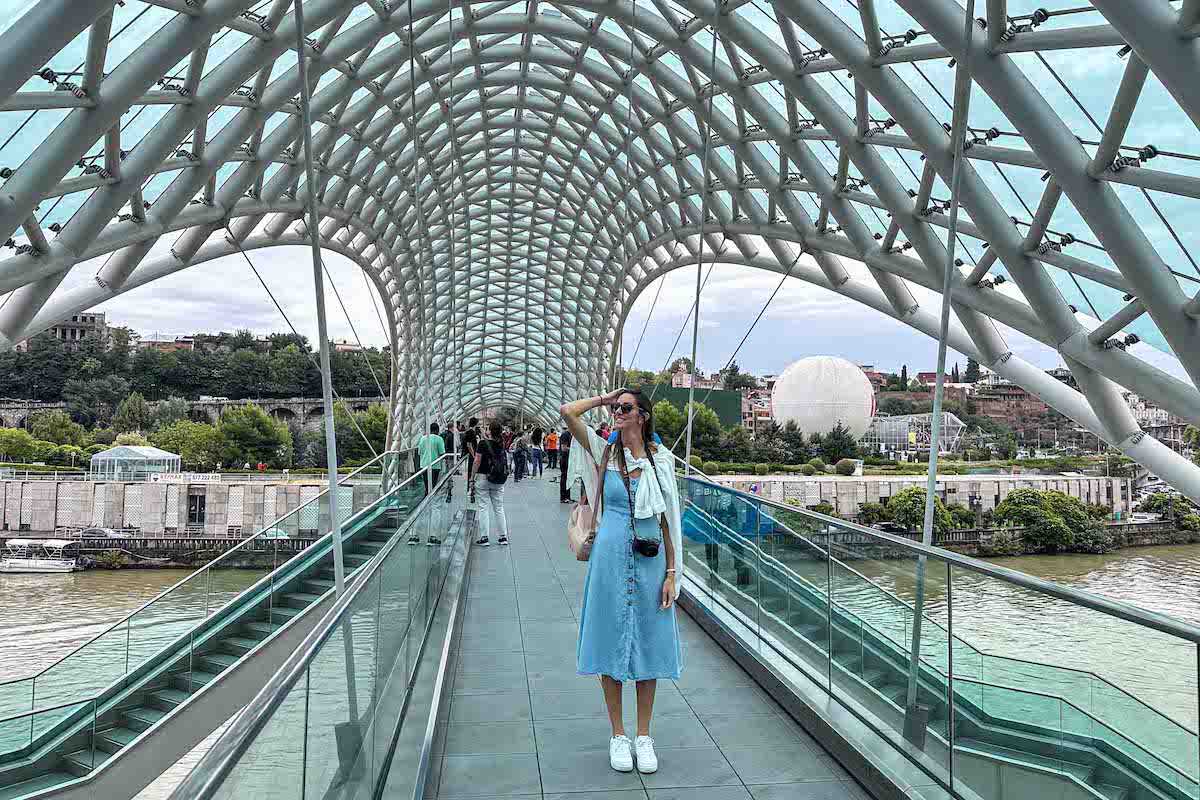
There are old wooden homes, beautiful parks and modern structures all mixed together. Walk across the Bridge of Peace, a modern pedestrian bridge over the Kura River, see the natural surfer springs, walk through Shardeni Street and stop for dinner, or head up the hill on the cable car.
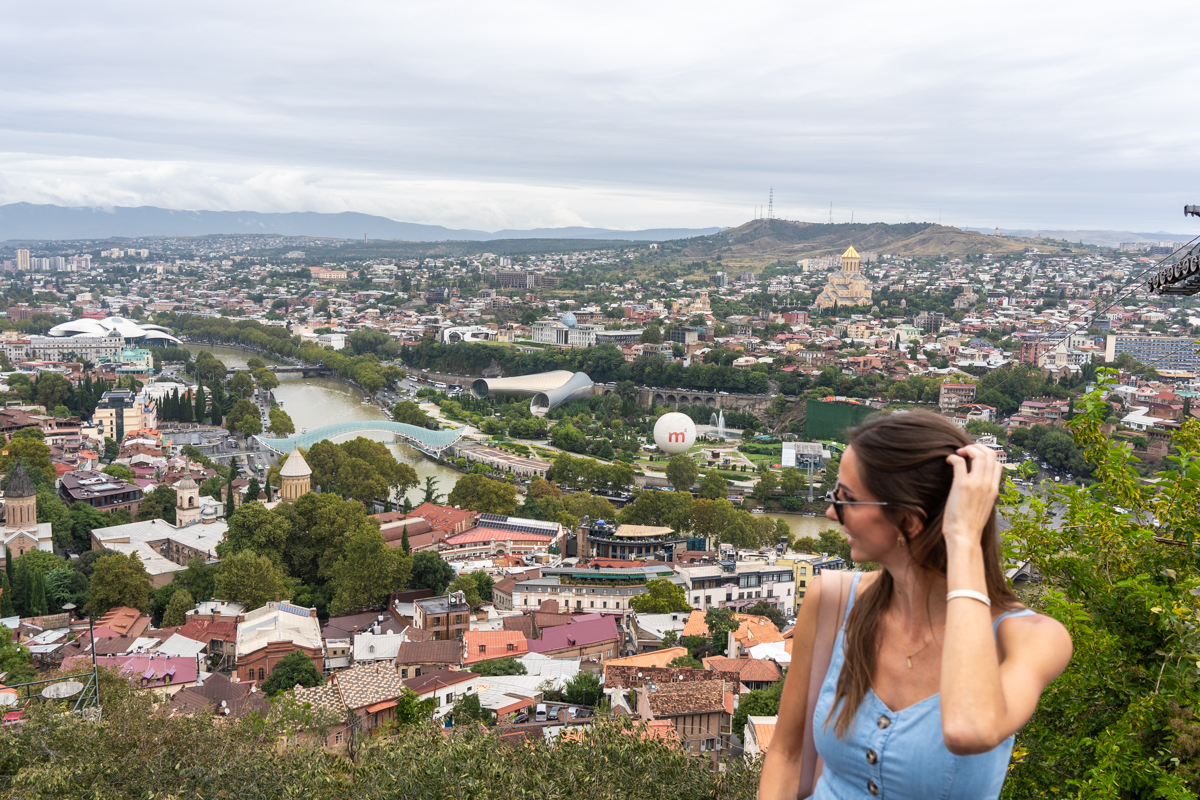
You can also explore several religious structures around the city like the Assumption Church, Sioni Church or Juma Mosque. On top of a nearby hill is the Narikala Fortress overlooking the city. There’s plenty to see here so make sure you take your time!
Mtskheta
One of my favorite areas to visit was Mtskheta. Mtskheta is located about 35 minutes outside of Tbilisi and was the first capital of Georgia. It’s also one of the oldest continuously inhabited cities in the world.

It’s such a charming place to walk around with cobblestone streets, intricate light posts, a stunning cathedral in the center and a fun walking street. It was here that we got to explore a lot of the local treats including churchkhela and wine ice cream (yep, actual wine ice cream–we thought the sign had a typo at first!).
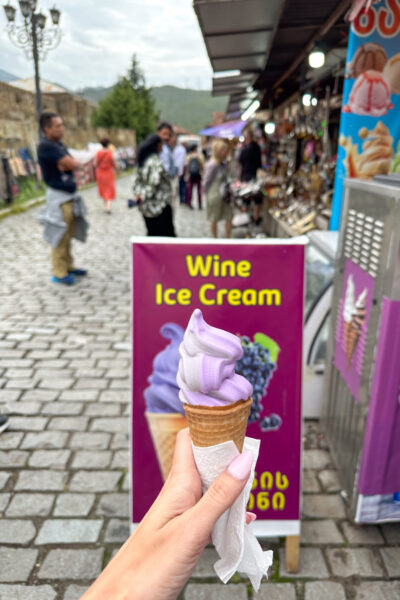
The Svetitskhoveli Cathedral is a UNESCO World Heritage Site and the grounds are beautifully landscaped. If you look up the hillside from the cathedral, you’ll also see the Jvari Temple overlooking the old city.
Mount Kazbek + Churches/Monasteries
One of my favorite days in Georgia is when we traveled through the mountains. The scenery is stunning and there are several highlights to see within the mountains. One of the most famous is the Gergeti Trinity Church that sits in front of Mount Kazbek. It’s an incredibly photographic spot.
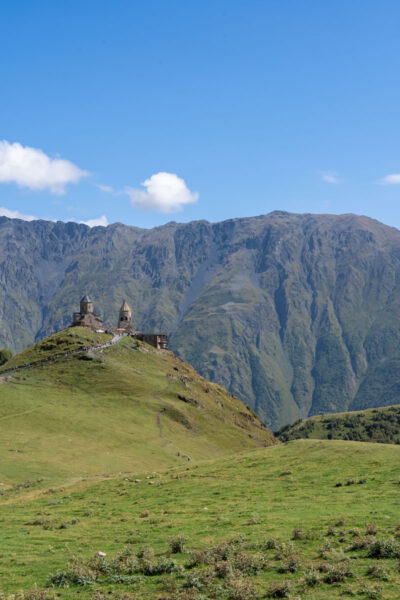
We also visited the Russia-Georgia Friendship Monument which has some of the most beautiful mountain views. Not to mention the structure is a large, round mosaic. Another highlight is the Ananuri Fortress, which looks like it’s straight out of a fairytale.

Armenia
From Georgia, you’ll again start to see the landscape change when traveling through Armenia. While it still has areas that are green and mountainous, Armenia has some drier and more rocky landscape as well. The capital city, Yerevan, is known as the ‘pink city’ as a lot of the buildings are made from the surrounding pink rock.
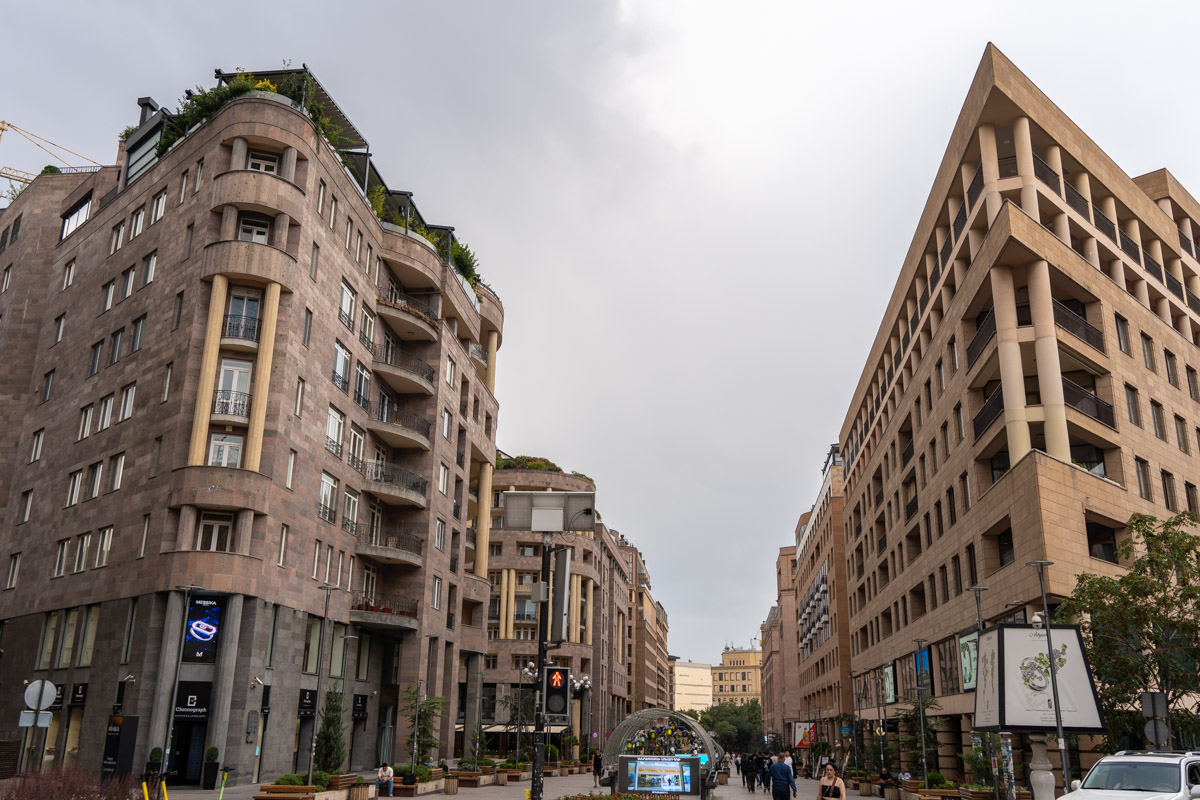
Armenia has a long religious history–it was the first country to establish Christianity as the nation’s religion back in 301 AD. And because of its long history, there are thousands of churches and monasteries all over the country.
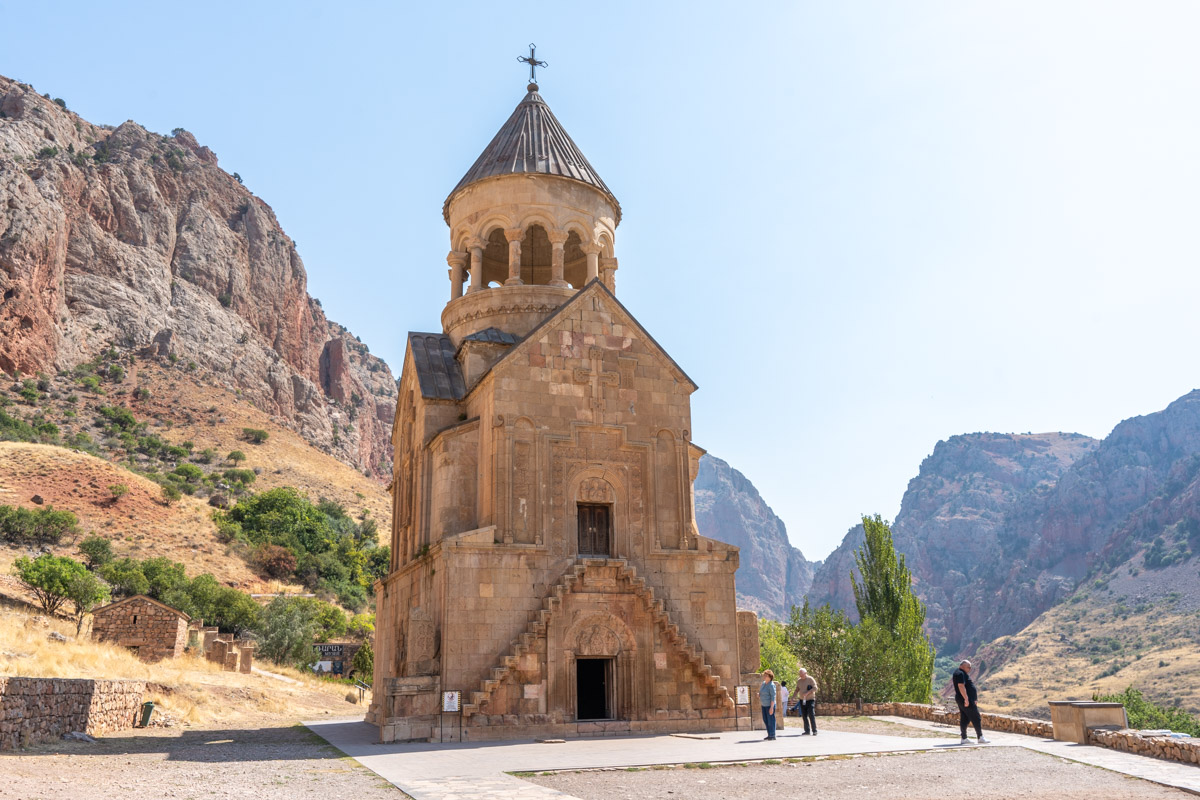
Like Georgia, it’s also a big wine producer and another big export is brandy. Fun fact, Yerevan actually has more brandy distilleries per capita than anywhere else in the world. And yes, that includes Cognac!
Yerevan
There’s a circular street that goes around the center of Yerevan and in the center is where you’ll find some of the popular highlights like Republic Square, the national gallery, the national theater, and Vernissage market (a popular street market).
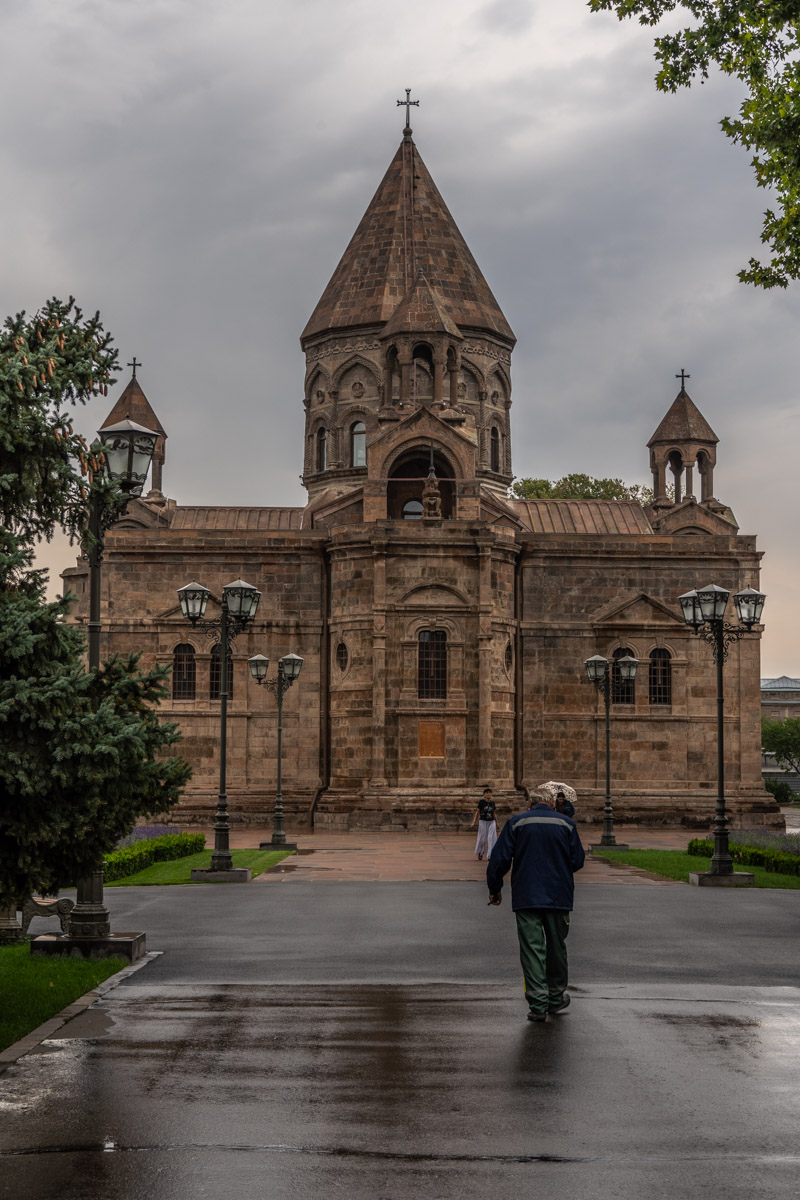
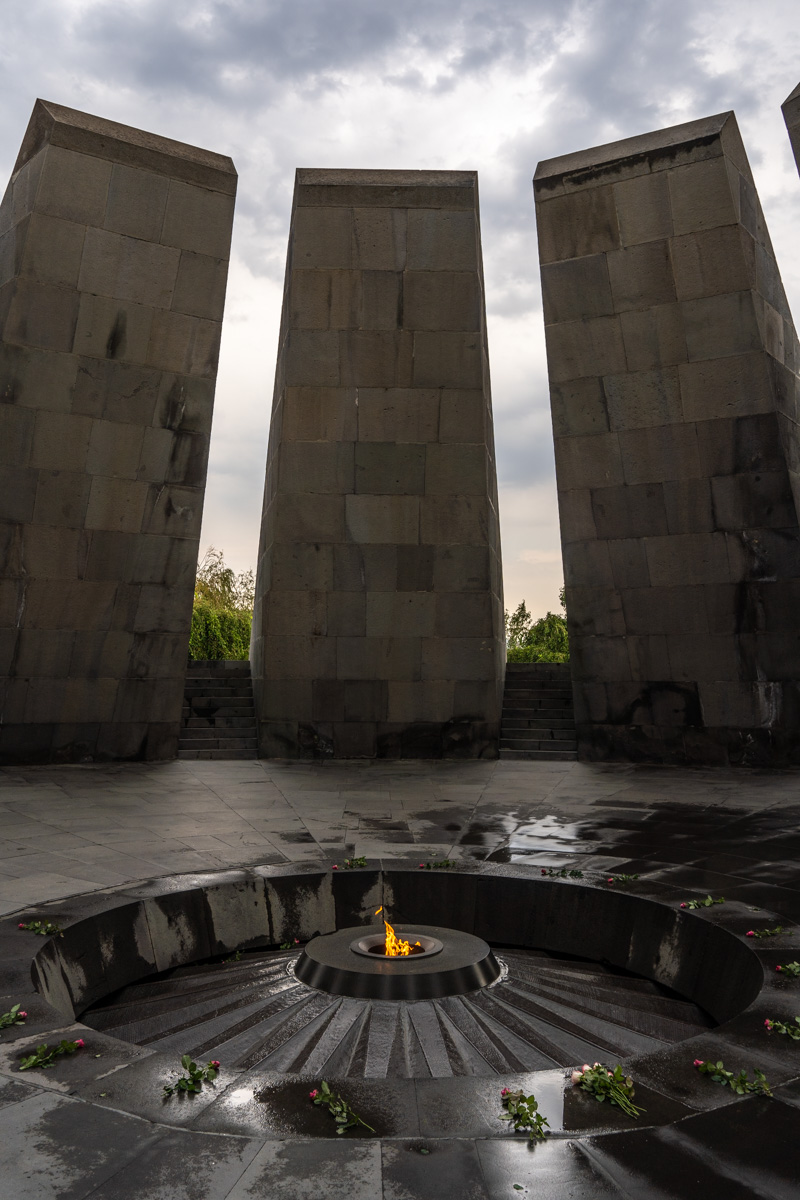
Also nearby is the Cascade Complex, a tiered structure overlooking a park with lots of artwork and sculptures. Head to the top at sunset for a great view of the city and if you’re lucky, a view of Mount Ararat. It was a little hazy when we went and you could just barely make out a feint outline.
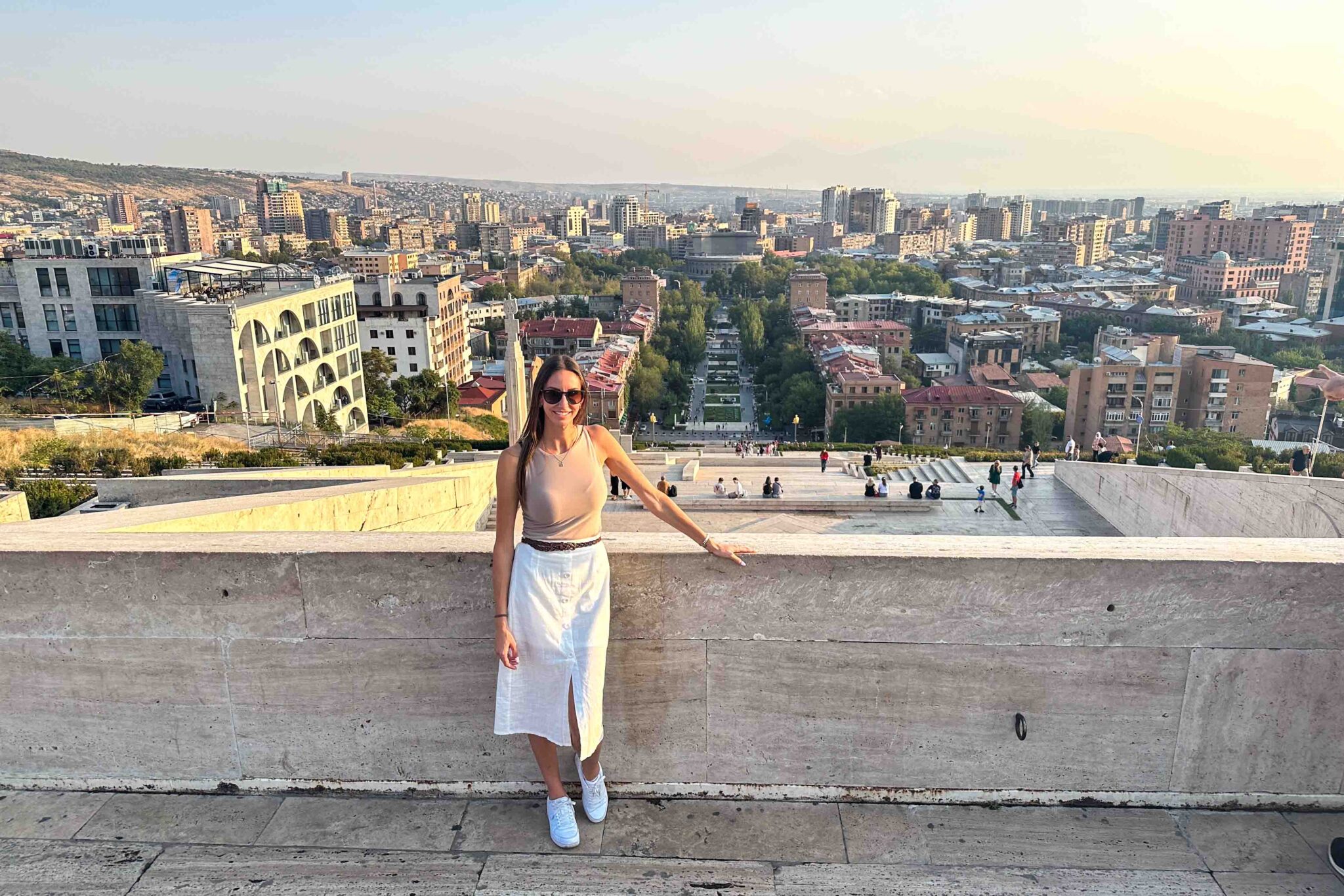
The city is easy to navigate and walk around with underground shopping centers to connect you under the streets. There’s lots of great outdoor cafes for casual drinks and dinners. And you’ll definitely want to try all the different foods here as well.
Monasteries
Armenia is definitely the land of monasteries. There are so many monasteries in Armenia and endless places to visit here. When we first arrived, we visited the Goshavank and Haghartsin monasteries on our way to Yerevan. The Haghartsin Monastery is nestled into the hills and probably is a great drone photo op.

Noravank is a monastery built to blend into the surrounding rocks and the Geghard Monastery is one that was built into the rock. They are interesting to visit but you’ll only be able to scratch the surface with how many there are.
And the most iconic monastery is Khor Virap–more on that below.
Mount Ararat
Mount Ararat is a famous mountain peak that’s actually located in Turkey, but can be seen from the border in Armenia. In biblical history, Mount Ararat is the peak that Noah’s ark landed on and is said to be the final resting place of the ark.
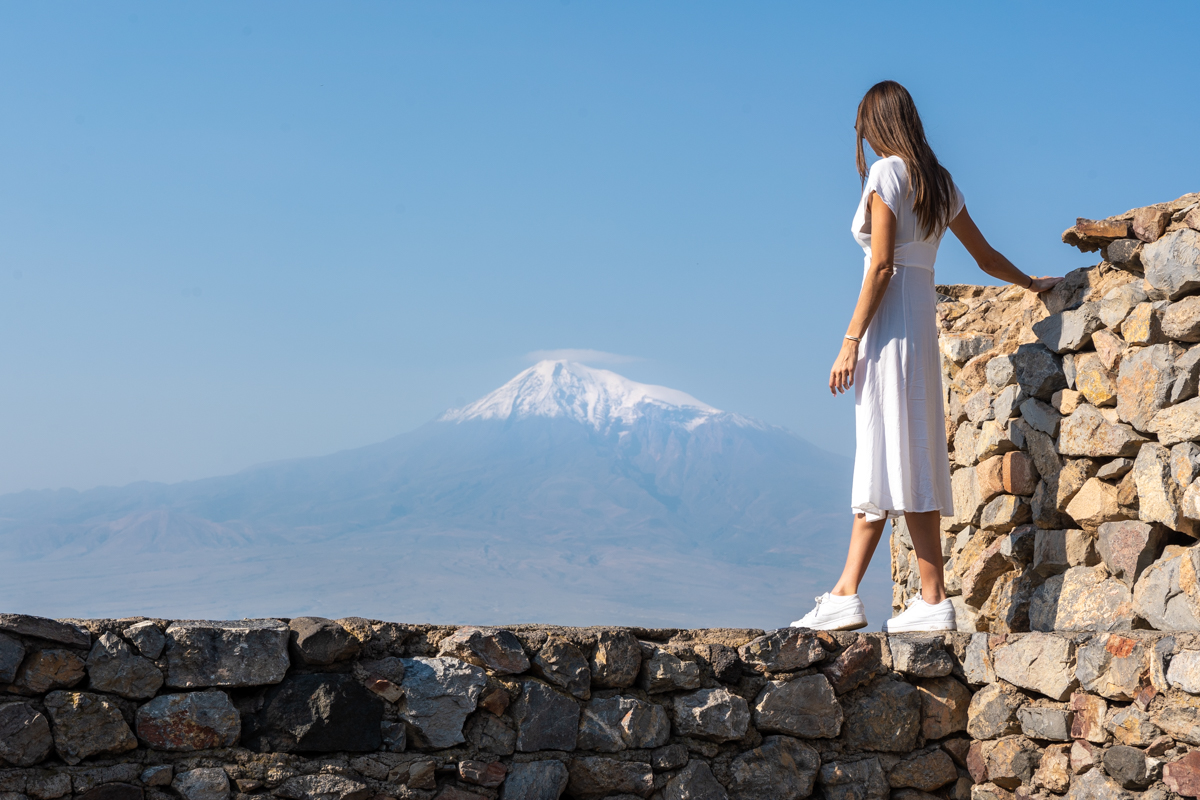
There are some iconic places in Armenia where Mount Ararat is the central focus. It can be seen from the city of Yerevan on clear days, but a famous location is the Zvartnots Temple. The temple ruins line up perfectly in front of the mountain for an iconic shot (just make sure you have a long zoom lens or the mountain perspective will be small). We unfortunately visited on a rainy day and didn’t have visibility.
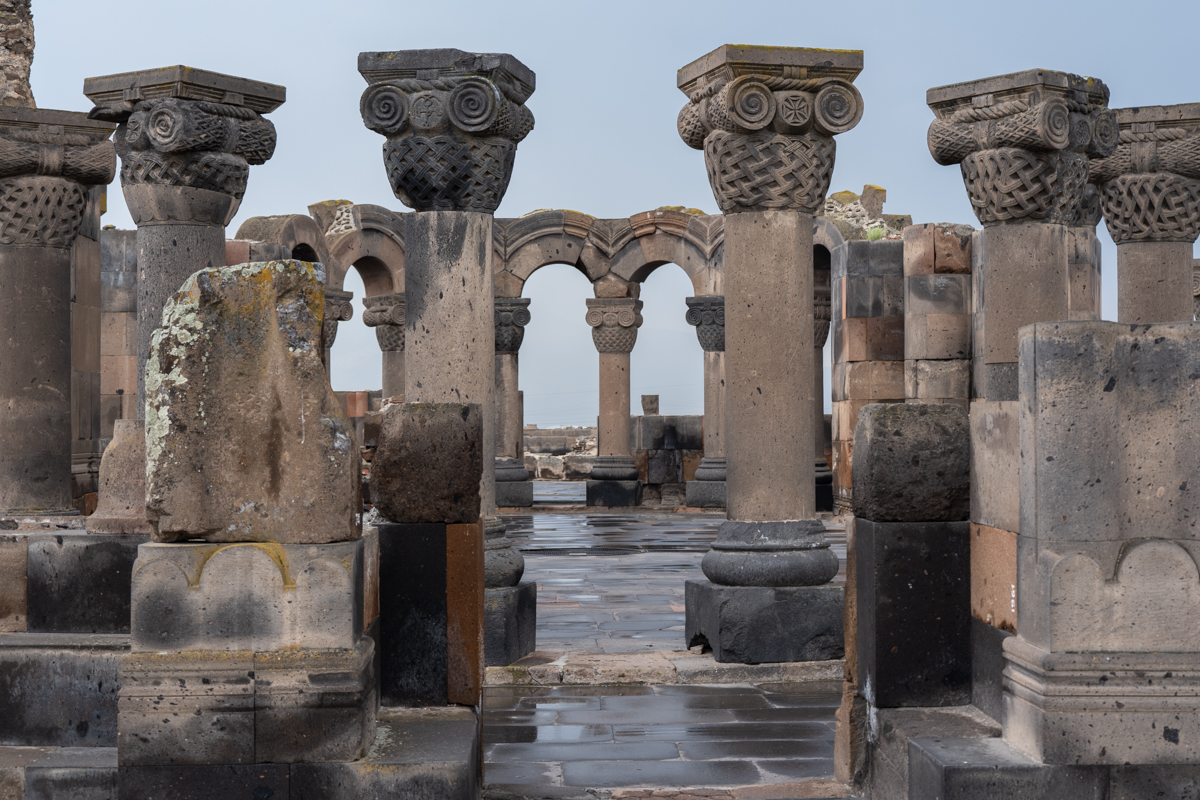
But even more famous is Khor Virap, a monastery that sits right near the border of Turkey and has a stunning view of Mount Ararat in the distance. We visited a sun flower field along the road that was in bloom and it’s my favorite shot of the trip.

Getting Around
Of all the capitals, I’d say Tbilisi and Yerevan were the most walkable from where we stayed. It all depends on what hotel you are at. Our place in Tbilisi was very central to restaurants and easy to walk around. The hotel in Yerevan was a 20-minute walk from the center and our hotel in Baku was about 25 minutes from the boardwalk by the sea.
We walked to dinner places most nights but getting around via ride share is super easy and incredibly affordable within the capitals. When we did decide to ride share back to the hotel, it was about a $2-4 trip. I’ve bolded the ones I recommend using!
- Azerbaijan: Uber AZ, Bolt or Yango (If using Bolt, opt for comfort + or higher as there have been some complaints online). *Uber AZ is a different app than the regular Uber app.
- Georgia: Bolt (does not have the same complaints as in Azerbaijan), Yandex Go. *Uber does not operate here
- Armenia: GG and Yandex Go. *Uber does not operate here
Safety
Safety was one of the first things our guide in Azerbaijan was asked about and he assured us we were incredibly safe in Baku for a few reasons. One, there are police officers on patrol everywhere, which there were. Two, there are cameras up all over the city. He told us that if you were to forget your phone somewhere, you could come back in an hour and it would still be there.
Also, we were told in all three countries that walking alone at night would not be an issue whatsoever. The cultures here are a bit different in that everyone is out at night.
The work day starts later and it’s very common to see families and kids out until midnight. People are walking the parks, grabbing late dinners/drinks–we were always surprised at how many people (and kids) were out late. And it was incredibly safe to be walking out at night.
As a woman, you also are typically aware of looks and catcalls from men when traveling. This is something I didn’t experience whatsoever in any of the three countries I visited. I never had uncomfortable stares or anyone say anything or do anything that made me feel uncomfortable. Quite the opposite.
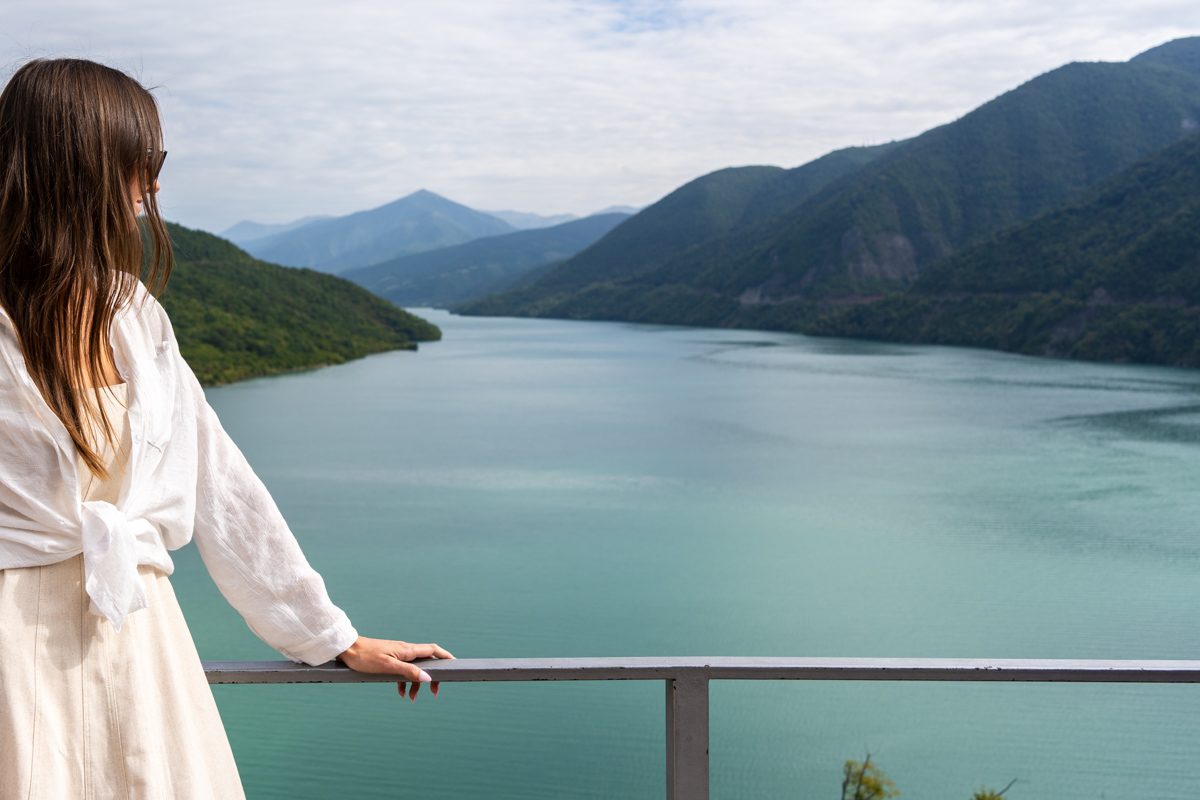
Things to Know
- Visas: As an American traveler, Azerbaijan was the only country I needed to get a visa for. You’ll need to apply for an e-visa ahead of time to leave room for processing (I did mine about a week prior) and show it to the airline at check-in + immigration when you arrive.
- Outlets: Type C and Type F are used (European countries use Type C). Both should be interchangeable but you can always use a universal adaptor
- Language: In Azerbaijan, the main language is Azerbaijani or Azeri. In Georgia, it’s Georgian (both of which have similarities to Turkish). And in Armenia, it’s Armenian. However, Russian and English are also common.
PIN IT FOR LATER


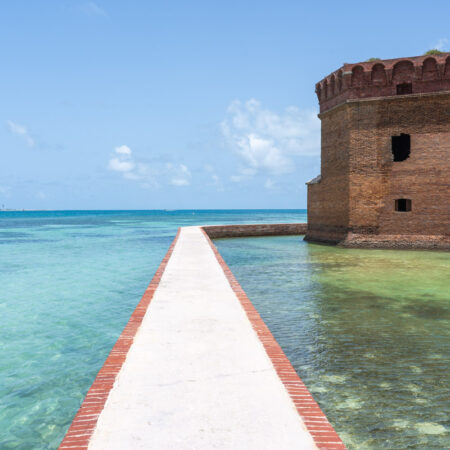
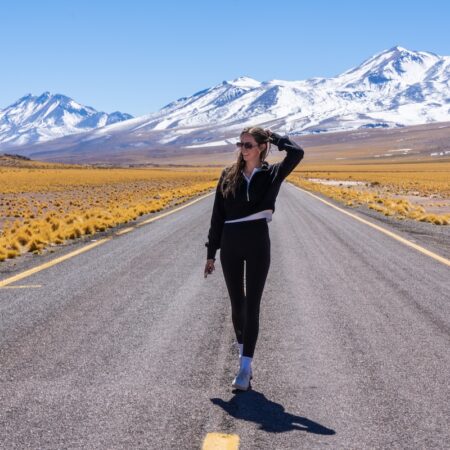
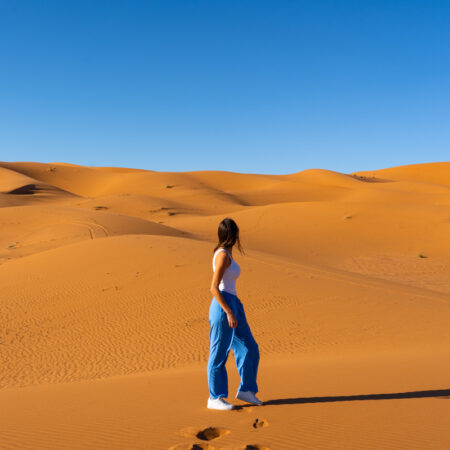
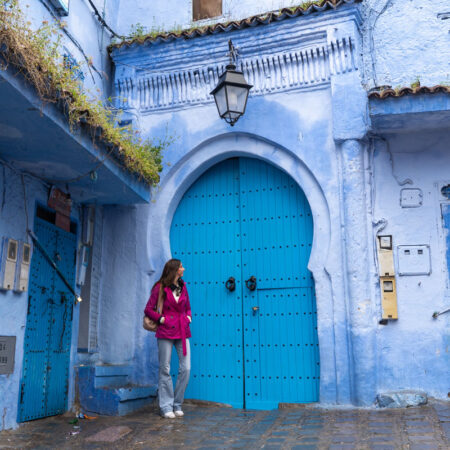

Leave a Reply